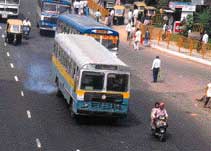Method behind the madness
 Three years ago (July 28, 1998), the Supreme Court (sc) ruled that the total passenger bus fleet of Delhi be increased from the then figure of about 6,000 to 10,000 by April 1, 2001 and the entire city bus fleet be converted to cng . The objective was to expand the city’s public transport system and also to control pollution. Incremental steps to bring in only new buses on cng would have taken over a decade to arrest the pollution in the world’s most polluted city. Not only were diesel buses contributing heavily to particulate pollution, the city also had possibly the highest bus density in the world. And it continues to grow rapidly with more and more vehicles hitting the roads. To deal with pollution from petrol-driven vehicles, the sc ordered the exclusive sale of unleaded and low benzene petrol and advanced improved Euro II vehicular standards by almost five years.
Three years ago (July 28, 1998), the Supreme Court (sc) ruled that the total passenger bus fleet of Delhi be increased from the then figure of about 6,000 to 10,000 by April 1, 2001 and the entire city bus fleet be converted to cng . The objective was to expand the city’s public transport system and also to control pollution. Incremental steps to bring in only new buses on cng would have taken over a decade to arrest the pollution in the world’s most polluted city. Not only were diesel buses contributing heavily to particulate pollution, the city also had possibly the highest bus density in the world. And it continues to grow rapidly with more and more vehicles hitting the roads. To deal with pollution from petrol-driven vehicles, the sc ordered the exclusive sale of unleaded and low benzene petrol and advanced improved Euro II vehicular standards by almost five years.
By August 2001, Delhi had the largest fleet of cng buses in the world. There were 2,394 buses, over 27,000 autos and 14,000 other vehicles running on cng . But without adequate supply of gas, the future of these vehicles looks bleak.
March 2001: The confusion game
When the deadline for converting the entire public passenger transport fleet to cng expired, all parties concerned thronged the sc to air their grievances
